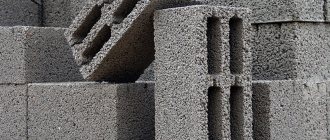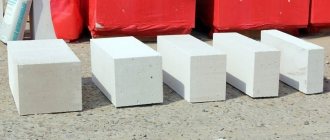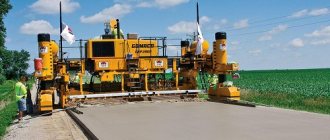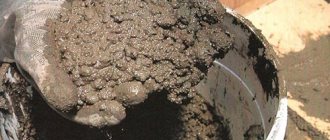Asphalt is a relatively cheap material that is widely used as a working surface for highways, playgrounds and other similar objects. It is based on bitumen and mineral materials that provide the necessary technological performance characteristics of the finished product.
Depending on the composition and method of laying, there are three main types of asphalt (according to GOST 9128, two: hot and cold, separated by characteristics):
- hot - laid using the well-known traditional technology at a temperature of the finished mixture of at least 110 ° C, which is due to the presence of viscous bitumen in its composition;
- warm - made on the basis of low-viscosity bitumen, therefore it requires laying at a mixture temperature of 40 to 80 ° C (this type of asphalt, in terms of application conditions, as well as a set of advantages and disadvantages, is similar to hot mixtures, therefore it often belongs to this group of materials);
- cold - produced on the basis of liquid bitumen, as a result of which it can be laid at fairly low temperatures, usually not lower than 5 ° C, but in some cases compositions for ambient temperatures from -30 ° C can be used.
| Type and type of mixtures and asphalt concrete | Brand |
| Hot: | I |
| — high-density | |
| - dense | |
| A | I, II |
| B, G | I, II, III |
| V, D | II, III |
| - porous | I, II |
| — highly porous crushed stone | I |
| - highly porous sand | II |
| Cold: | |
| Bx, Bx | I, II |
| Gh | I, II |
| Dx | II |
| — highly porous crushed stone | I |
The basic requirements for mixtures for arranging asphalt pavements are given in GOST 9128, according to which hot or cold asphalt of different types and types can be used. The first option requires the use of mixtures heated to temperatures above 110 ° C, and the second is simpler, since it can be made on the basis of material at room temperature or lower.
Composition and characteristics of hot asphalt
According to GOST 9128, the category of hot asphalt concrete mixtures includes materials based on liquid and viscous petroleum road bitumen. Depending on the content of gravel or crushed stone, porous, highly porous (sand and crushed stone), high-density and dense (types A, B/G, V/D) types of asphalt concrete are distinguished. The residual porosity of high-density mixtures is 1-2.5%, dense - 2.5-5%, porous - 5-10%, highly porous - over 10%. Type A is produced on crushed stone (50-60%), and types B and C are produced on gravel or crushed stone (40-50% and 30-40%, respectively). Type G is made from crushed sand, and type D is made from natural sand or a mixture of natural and crushed sand.
Thanks to the use of inexpensive bitumen, hot asphalt remains the most popular material for the construction of roads, airfields and other surfaces. Its advantages include low price, high frost resistance and cold resistance of the finished asphalt, the ability to vary characteristics over a wide range, strength and durability. The main disadvantage is the need to use special equipment and the relative difficulty of ensuring the specified characteristics of the material during the installation process.
Hot and warm asphalt concrete - manufacturing technology
The operating temperature of hot asphalt is about 110°C, warm asphalt mixtures are from 40 to 80°C. This is a classic technology for laying asphalt road and sidewalk pavements, which consists of thermal plasticization of bitumen and its hardening after laying, leveling and rolling.
Most asphalt plants use classic hot asphalt production technology.
- The crushed stone is dried at a temperature of about 150°C and then sifted on a screen. The solid filler is supplied to the asphalt plant in a wet state, which is unacceptable in the production of asphalt concrete.
- Mixing the filler with bitumen at a temperature of about 170°C, which is maintained until the asphalt is laid.
- Adding additives and modifiers. These are components that improve the operational and laying characteristics of asphalt concrete.
Ready hot can be stored for no more than two days. It has strict seasonal boundaries - summer and dry, warm weather in spring and autumn.
Hot asphalt laying technology
Laying of hot asphalt must be carried out in accordance with the requirements of SNiP 3.06.03-85 according to the following scheme:
- preparation of the subgrade base;
- development of excavations and arrangement of embankments;
- strengthening and finishing works;
- construction of a subgrade (technology varies depending on soil types), including the use of geosynthetic materials;
- arrangement of additional (drainage, frost-protective, capillary-interrupting, insulating) layers and layers of sand, gravel, crushed stone, concrete, stone materials, polystyrene foam, geomembranes, etc.;
- treating the base with a bitumen mixture;
- preparation and transportation of hot asphalt concrete to the construction site for reasons of compliance with the specified temperature conditions;
- laying hot mixtures using an asphalt paver with a thickness margin of 10-15% higher than the design (at temperatures from 0 to 5 ° C, work can only be carried out if the special requirements of SNiP are met).
One of the main disadvantages of hot asphalt is the weather restrictions. The most suitable period for this is considered to be the summer season; in the spring-autumn period, work can be carried out in a limited manner, and in winter it is prohibited.
Cold and hot asphalt: what is the difference between technologies
The composition of the cold and hot mixtures is almost the same, with the exception of some nuances. For example, a cold mixture contains solvents, which make the bitumen liquid and suitable for repairs in the cold season. Solvents interact with plasticizers and trigger the process of evaporation of hydrocarbons, which, in turn, affects the bitumen.
The mixture contains crushed stone. But these are usually small stones, which, due to their fine fraction and specific shape, are better compacted.
Cold asphalt concrete is suitable for working at low air temperatures. It does not need to be heated or compacted using expensive equipment. Hot asphalt cannot be laid at low temperatures.
Composition and features of cold asphalt
Cold asphalt is made from liquid petroleum bitumen and aggregate. Depending on the content of gravel or crushed stone, highly porous (crushed stone) and dense (types Bx/Bx, Gx and Dx) types of asphalt concrete are distinguished. Types Bx and Bx are produced on gravel or crushed stone: content 40-50% and 30-40%, respectively. Type Gx is made from crushed sand, and type Dx is made from natural sand or a mixture of natural and crushed sand.
One of the most significant benefits of cold asphalt is its long-term performance. Therefore, the material can be used for installation in a wider temperature range, including in winter. Thanks to the use of special additives, cold asphalt has high adhesion to the base material.
Distinguished by its higher cost, cold asphalt allows high-quality and quick construction of various sites under light loads, as well as all types of pothole repairs, including on highways. In addition, due to its low shear resistance, the material is not used in areas where heavy traffic braking occurs.
What is cold asphalt and what does it consist of?
To understand what cold asphalt is and what are the features of its use, you need to know its composition. The difference between a hot and cold mixture lies in the ratio of components and some features of their use.
Includes:
- Crushed stone. Usually this is gray and black crushed stone in the form of small fractions. The material is thoroughly washed to ensure good adhesion during installation.
- Liquid bitumen. To ensure that the mixture can be laid in frost without problems, only liquid bitumen is used.
- Specially purified sand.
- Plasticizers. They create a film on the surface of the crushed stone, which does not allow the hydrocarbon to evaporate until the material is laid.
- Solvent. Plays the role of a catalyst that provokes the evaporation of hydrocarbons.
For reference!
Each manufacturer decides for himself in what proportion to mix the elements and what additives to use. All this affects the quality of the mixture and the future surface.
Cold asphalt laying technology
Since cold asphalt is recommended for repairing road surfaces, the technology for performing the work is extremely simple. At the first stage, the damaged area is prepared for laying by removing the top layer of the road surface, removing dust and dirt, and then covering it with cold asphalt. Next, the mass is compacted, which can be done without the use of special equipment (hand roller or vibratory rammer). It should be remembered that the layer thickness should provide a margin of 56-60% relative to the design one. If the depth of the pit is more than 80 mm, then laying is done in several layers.
When constructing a new roadway, you should adhere to the technology described in SNiP 3.06.03-85, taking into account the special requirements for the use of cold asphalt concrete. In addition, when performing work in winter, you must follow the instructions of the mixture manufacturer.
In general, cold asphalt is easy to lay and is recommended for use both when performing repair work and when arranging paths, alleys, and areas that do not experience heavy loads. This coating can be laid at any time of the year without the use of heavy special equipment.
How to lay cold asphalt: road repair and paving
Cold paving is easier than hot paving. But the technology still has its own nuances that must be taken into account. At the same time, pothole repair and creation of an entire coating will differ.
Scheme of pothole repair:
- Preparing the surface. We remove debris, foreign objects, dirt and dust. Can be used for cleaning with water jet.
- We process the edges. In the area of work, the edges are cut off to increase the adhesion of materials.
- Cover with liquid bitumen. The edges of the hole or crack are treated with bitumen so that the materials are better bonded to each other. The average consumption is 500 ml of bitumen per 1 sq. m.
- Add crushed stone. If the hole is deep - more than 20 cm - it is worth filling it with crushed stone, and therefore with cold asphalt. This will reduce material costs, and the quality will remain high.
- Lay a layer of cold asphalt. It is advisable that after installation the patch protrudes 2 cm above the road surface. During operation, the difference will equalize.
- We seal the patch. To do this, you can use manual equipment, a vibrating roller, or your own transport.
Tamping is done from the edges to the center in a spiral. When the tamping equipment no longer leaves marks on the surface of the coating, the process can be completed. This usually happens after 10 passes.
Now let's figure out how to work with cold asphalt if you are planning to asphalt a path or an entire area from scratch.
Asphalting scheme for local areas:
- Preparing the foundation. We make a depression in the selected area: usually it is enough to remove 10–15 cm of soil.
- We compact the “trough”. A hand tool works well for this.
- Assembling the pillow. First we fill in a layer of sand and compact it, then repeat the same with crushed stone.
- We water the base with bitumen so that it adheres well to the asphalt layer.
- We lay cold asphalt. The material must be carefully leveled.
- Let's start tamping. This can be done with hand tools or with special equipment.
If you are making a site or road that will be frequently used by vehicles, we recommend using geotextiles or geogrid. It is laid between several layers of asphalt mixture. It is not necessary to use reinforcing materials to create pedestrian paths and pave playgrounds.
Characteristics and applications
The areas of application of this material are determined by its special qualities, which include:
- Available for sale in a form completely ready for creating road surfaces.
- Can be transported in small trucks or truck trunks.
- Long shelf life when prepared. The mixture without containers can be stored for up to 12 months, with correctly selected containers (most often polyethylene) - up to 24 months without loss of performance characteristics.
- Wide range of temperatures at which installation can be carried out: from -15 to +40°C.
- High speed of work, no need to involve heavy equipment and numerous workers.
- Safe to use due to the absence of hot processes.
The main difference between cold asphalt concrete and hot one is the increase in strength as a result not of the cooling of the material heated before laying, but of the evaporation of hydrocarbons contained in its components.
Cold asphalt concrete mixture is used for:
- Carrying out urgent restorative pothole repairs on roads with varying degrees of traffic load, areas near gas stations, car parks in the courtyards of multi-storey buildings. While its hot-laid counterpart requires a carefully prepared dry base, cold asphalt is less demanding on weather conditions and base moisture.
- Waterproofing flat roofs.
- Devices for blind areas from the foundation.
- Asphalting of garden paths and local areas.
- Sealing of bridge and road thermal expansion joints.
- Restoring the coating after installing drainage grates.
Scope of application of the material
Typically, cold asphalt is laid in areas where it will not be exposed to pressure from cars and trucks. For example, it is used to create pedestrian paths and platforms. The mixture is also used for the following procedures:
- partial road repairs in cold weather;
- urgent road repairs that require rapid hardening of the material;
- creating paths in parks;
- laying paths in local areas;
- asphalting driveways to houses;
- repairs after installation of gutters;
- installation of sewer hatches.
Cold laying mortar is popular for self-construction because it does not require special equipment. For this reason, it is often used by owners of private houses for asphalting their local area.
Cold styling equipment
When constructing pedestrian sections, cold laying does not require special equipment such as road rollers - manual equipment will be quite sufficient. Carrying out pothole repair is a more serious task, so for such a procedure it is better not to neglect the use of large equipment.
For cold installation you may need the following equipment:
- a jackhammer or sledgehammer with a hand cutter are necessary tools for preparing potholes for filling;
- air compressor - a device for quickly removing debris from pits;
- road roller - special equipment for compacting roads;
- vibrating plate - a device for compacting paths that can be used instead of a roller;
- manual roller - simple equipment for compacting paths;
- car – can also be used for compacting asphalt;
- manual trowel for asphalt – used to level the laid mixture.
To lay a pedestrian path in a local area, only two tools will be enough: a roller and a trowel. All other work can be done with improvised means, which are found in every country house.
Asphalt paving equipment
At all stages of asphalt paving, special road construction equipment is used. It not only speeds up the process of laying the road surface significantly, but also significantly improves the final quality of all work. Below is all the necessary equipment for asphalt paving:
Bulldozer
A bulldozer is a self-propelled road construction machine with cyclic action. Equipped with a knife working body. Main purpose: carrying out excavation and transport work.
Bulldozers are widely used and are intended for all stages of construction work:
- to prepare the soil base,
- to apply a sand and crushed stone layer,
- to prepare the road base for asphalting.
Bulldozers are either tracked or wheeled. Crawler bulldozers are designed for work in off-road and difficult terrain conditions and have great power and endurance.
Wheeled bulldozers have lower productivity, but are characterized by high maneuverability. Can work in small areas. They are used for constructing road bases, while tracked ones are better suited for earthmoving work.
Loader
The loader is a self-propelled or manual machine. The main purpose is to lift, transport and stack heavy loads.
Bucket loaders are also divided into tracked and wheeled. The former have greater power, productivity and endurance, the latter are intended for simple work in small areas.
Loaders are universal equipment because they can be equipped with a wide variety of attachments:
- bulldozer blades,
- ladle,
- scraper working bodies, etc.
This technique is used for laying asphalt concrete pavement and subsequent cleaning of the area from construction debris, and, if necessary, fallen leaves, snow, branches, etc.
Grader
The main purpose of the grader is planning and profiling the work area. This is a self-propelled or trailed machine that is used to level the soil and then move it. It is also used for cleaning areas from loose construction materials and snow.
Asphalt concrete paver
An asphalt concrete paver is a type of construction equipment that can be tracked or wheeled. The asphalt concrete paver is designed for laying asphalt concrete mixtures. Depending on the type of work to be done (their volume and complexity), machines can be heavy or light. Large equipment is needed at large road construction sites, while light equipment is used for auxiliary work.
Stages of laying asphalt
Design and estimate documentation is being developed
The project must be developed taking into account the characteristics of the site , which has its own individual characteristics (type of relief, parameters, soil structure). After the specialist’s calculations, an estimate , which takes into account:
- plot size,
- volume of work,
- preliminary cost.
The location of underground communications is also included in the calculation. This is necessary for the correct calculation of the drainage system, which will help avoid problems with wastewater disposal in the future.
Due attention should be paid to the root system of large trees, as over time the roots can grow and seriously damage the road surface.
Excavation
Preparatory work begins. First of all, the top layer of soil is removed. If the task is to remove a large layer, the use of specialized equipment - bulldozers and loaders - is required. The territory is leveled using graders. Subsequently, a road “trough” is formed, which will undergo further compaction.
How deep to dig? First of all, the indicator depends on the purpose of the roadway. To lay paths, it is enough to remove 15-25 cm of soil. The rule applies here: the greater the planned load on the canvas, the deeper the pit is dug.
Important! The project should be designed so that rainwater flows into the drainage system and does not accumulate on or under the asphalt surface.
If the work is not done from scratch, the existing coating is destroyed using a road router. Obsolete coating can be reused if recycled correctly.
Do you want to buy sand or crushed stone with delivery?
Call now and get a discount +7 (988) 318-84-49
The foundation is being prepared
At this stage, a “road cushion” is formed. The task is to pour two layers of the road “pie”:
- Sand or gravel-sand mixture is laid.
- To give strength, the top of the coating is sprinkled with coarse crushed stone.
- To minimize voids, the cake is additionally covered with crushed stone with a fine fraction.
To ensure that the coating does not lose its quality characteristics over time, each layer must be leveled using a grader and carefully compacted. Side stone is used to fence off an asphalted area.
Important! To give the coating maximum strength, the surface should be impregnated with bitumen before paving.
Scheme of the correct road “pie”
Laying asphalt
The final stage. If the material is not prepared directly on site, delivery is carried out using dump trucks. Sand, mineral powder, liquid bitumen and crushed stone are the key components of ABS (asphalt concrete mixture) .
When applying the mixture, it is important that it spreads evenly. To avoid uneven surfaces, they use asphalt pavers. To increase the density of the coating, laying is carried out with several rollers. It is recommended to use equipment that is specifically designed for each individual type of work. Only in this case the coating will be of high quality.











